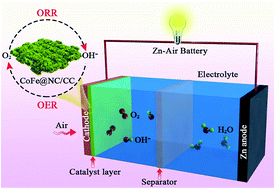N-Doped carbon coating enhances the bifunctional oxygen reaction activity of CoFe nanoparticles for a highly stable Zn–air battery†
Abstract
The construction of a high performance and stable non-precious metal–air-cathode is of great significance for a Zn–air battery (ZAB). Herein, 3D nanosheets consisting of N-doped carbon conglutinated CoFe alloy nanoparticles grown on carbon cloth (CoFe@NC/CC) have been prepared through simple electrodeposition and subsequent thermal decomposition. The cathode showed excellent activity and stability for the bifunctional oxygen reduction reaction (ORR) and the oxygen evolution reaction (OER), due to the synergic effect of the CoFe alloy and the N-doped carbon conglutinated structures. Density functional theory (DFT) calculations demonstrated that the introduction of the N-doped carbon structures can greatly weaken the O2 adsorption energy on the CoFe alloy nanoparticles, thus enhancing the bifunctional ORR/OER activity of the catalyst. As a binder-less self-supporting electrode, the assembled liquid ZAB showed a high open circuit voltage of 1.469 V, and it could be stably cycled for more than 400 cycles with a charge–discharge voltage gap of 0.77 V at a current density of 10 mA cm−2, surpassing the performance of Pt/C + RuO2/C benchmarks and other reported CoFe-based electrocatalysts. Furthermore, the all-solid-state ZAB was shown to be a battery with good flexibility for wearable electronics, satisfying the requirements of next-generation sustainable active electronics.



 Please wait while we load your content...
Please wait while we load your content...